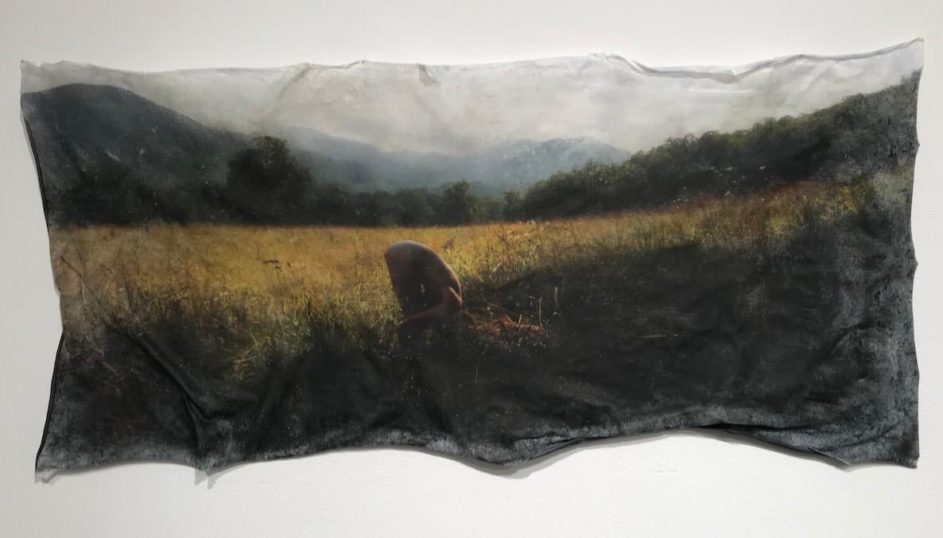For many years, Arrowmont School of Arts and Crafts in Gatlinburg has presented an exhibition of work by Sevier County artists and craftspeople. In contrast to much of the cutting-edge work Arrowmont shows throughout the year, the Sevier County show has traditionally featured more conservative work, often by artists and craftspeople whose primary focus is producing work to sell to the tourists who come to Sevier County each year.
Gradually, as more younger people have set up studios in Sevier County, the character of the biennial show has shifted to include more contemporary pieces.
The opening reception for the 19th Sevier County Biennial Juried Exhibition is 6-8 p.m. today (Jan. 25). The show will be in the main gallery at Arrowmont through March 2. It’s an even mix of the traditional and the new.

Two executions of Andrea Wilson’s “Dahlias.” On the left is her values drawing, done on tracing paper, with the full-color final painting on the right.
Two of the more striking pieces are a traditional watercolor and a pencil drawing of the exact same subject, dahlias, by Andrea Wilson. They are intentionally exhibited separately so what is a preliminary pencil preparatory drawing for the later watercolor and gouache painting stands on its own merits. Both are exquisite work.
The pencil drawing of the dahlias is a values drawing done on thin onionskin paper that artists and architects everywhere call “white trash” because it is often used for preliminary sketches, or tracing over images, then later thrown in the trashcan. There’s “yellow trash,” too. The purpose of values drawings is to evaluate depth and shadow in an image while studying a composition.
(The white spots in the image are the reflection of the gallery lights in the glass of the frame, a problem that can be seen in other photographs shown here.)
Except that in this case, Wilson’s “Dahlias Value Study,” graphite on tracing paper, 2017, is so beautifully done it deserves to be exhibited on its own. Its companion piece, the exact same image completed a year later, “Dahlias,” watercolor and gouache on vellum, 2018, is hung in another spot in the gallery. It is nothing short of gorgeous with the flowers practically glowing.

Logan Szymanowski’s “Gubbin’s Bad Dream,” lithograph, 2018, on the left, with Tatiana Tikhonova’s “She Always Comes Back,” linocut, 2018, on the right
Two other works in the show are also classical art production techniques. Tatiana Tikhonova’s “She Always Comes Back,” linocut, 2018, is a print made by spreading ink on the image cut into a block of linoleum, then the paper is pressed against the block and a roller is used to press the paper against the inked image.
The picture is of a father sitting at the kitchen table waiting for his runaway daughter to come back home. Although the image is filled with inked marks that fill the picture space, the image has a sense of emptiness and longing.
Logan Szymanowski’s “Gubbin’s Bad Dream,” lithograph, 2018, is made in a similar way, except the image is made with a mixture of gum arabic and acid etching into a metal plate or a smooth-face stone. Stones have been used for centuries, with metal plates coming later as metal became more accessible. The image is produced by drawing with wax or oil. Historically, even sticks of hardened animal fat were used as drawing tools. Water-based ink is then spread on the plate or stone. The ink naturally moves away from the areas where the oil drawing is.
The waves and clouds in the drawing could be components in images from the 17th century forward. But the panicking monkey is right out of a modern horror film.

Bill Griffith’s “Dwelling I,” wood-fired clay, natural ash glaze, 2017 (All photos by Harold Duckett)
Bill Griffith’s “Dwelling I,” wood-fired clay, natural ash glaze, 2017, is a sculpture made of clay, fired in a traditional kiln heated to high temperatures using wood. It’s the way ceramics have been made for thousands of years. But Griffith’s sculptural image is decidedly modern.
Another piece in the show, a photograph made by using new techniques, but with a very contemporary bent is Alyssa Coffin’s “Border Stalker,” 2018, a digital photograph, manipulated in the computer, then digitally printed on coated paper. The finished print was then manipulated further with matte gel to alter the print’s shape and texture and transform it from even being read as a photograph. It’s an East Tennessee landscape, with a bent-over figure in the foreground. The female figure’s nudity, seen from the shaded side, is barely distinguishable in contrast to the sun-lit meadow behind her.
The Sevier County artists’ show continues at Arrowmont until March 2. It’s worth the drive to Gatlinburg to see it. During the government shutdown, there is less traffic in Sevier County than there usually is. So now is a good time to see this high-quality exhibition. Gatlinburg restaurants, shops and hotels would certainly appreciate your business.

